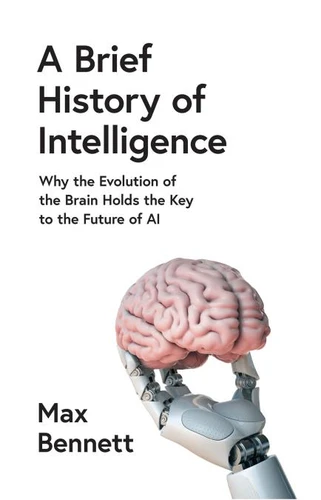A Brief History of Intelligence. Why the Evolution of the Brain Holds the Key to the Future of AI
Par :Formats :
Disponible dans votre compte client Decitre ou Furet du Nord dès validation de votre commande. Le format ePub protégé est :
- Compatible avec une lecture sur My Vivlio (smartphone, tablette, ordinateur)
- Compatible avec une lecture sur liseuses Vivlio
- Pour les liseuses autres que Vivlio, vous devez utiliser le logiciel Adobe Digital Edition. Non compatible avec la lecture sur les liseuses Kindle, Remarkable et Sony
- Non compatible avec un achat hors France métropolitaine
 , qui est-ce ?
, qui est-ce ?Notre partenaire de plateforme de lecture numérique où vous retrouverez l'ensemble de vos ebooks gratuitement
Pour en savoir plus sur nos ebooks, consultez notre aide en ligne ici
- Nombre de pages432
- FormatePub
- ISBN978-0-00-856011-9
- EAN9780008560119
- Date de parution24/10/2023
- Protection num.Adobe DRM
- Infos supplémentairesepub
- ÉditeurWilliam Collins
Résumé
Bridges the gap between AI and neuroscience by telling the story of how the brain came to be.
'I found this book amazing' Daniel Kahneman, Winner of the Nobel Prize in Economics and bestselling author of Thinking Fast & Slow
The entirety of the human brain's 4-billion-year story can be summarised as the culmination of five evolutionary breakthroughs, starting from the very first brains, all the way to the modern human brains.
Each breakthrough emerged from new sets of brain modifications, and equipped animals with a new suite of intellectual faculties. These five breakthroughs are the organising map to this book, and they make up our itinerary for our adventure back in time. Each breakthrough also has fascinating corollaries to breakthroughs in AI. Indeed, there will be plenty of such surprises along the way. For instance: the innovation that enabled AI to beat humans in the game of Go - temporal difference reinforcement learning - was an innovation discovered by our fish ancestors over 500 million years ago.
The solutions to many of the current mysteries in AI - such as 'common sense' - can be found in the tiny brain of a mouse. Where do emotions come from? Research suggests that they may have arisen simply as a solution to navigation in ancient worm brains. Unravelling this evolutionary story will reveal the hidden features of human intelligence and with them, just how your mind came to be.
Each breakthrough emerged from new sets of brain modifications, and equipped animals with a new suite of intellectual faculties. These five breakthroughs are the organising map to this book, and they make up our itinerary for our adventure back in time. Each breakthrough also has fascinating corollaries to breakthroughs in AI. Indeed, there will be plenty of such surprises along the way. For instance: the innovation that enabled AI to beat humans in the game of Go - temporal difference reinforcement learning - was an innovation discovered by our fish ancestors over 500 million years ago.
The solutions to many of the current mysteries in AI - such as 'common sense' - can be found in the tiny brain of a mouse. Where do emotions come from? Research suggests that they may have arisen simply as a solution to navigation in ancient worm brains. Unravelling this evolutionary story will reveal the hidden features of human intelligence and with them, just how your mind came to be.
Bridges the gap between AI and neuroscience by telling the story of how the brain came to be.
'I found this book amazing' Daniel Kahneman, Winner of the Nobel Prize in Economics and bestselling author of Thinking Fast & Slow
The entirety of the human brain's 4-billion-year story can be summarised as the culmination of five evolutionary breakthroughs, starting from the very first brains, all the way to the modern human brains.
Each breakthrough emerged from new sets of brain modifications, and equipped animals with a new suite of intellectual faculties. These five breakthroughs are the organising map to this book, and they make up our itinerary for our adventure back in time. Each breakthrough also has fascinating corollaries to breakthroughs in AI. Indeed, there will be plenty of such surprises along the way. For instance: the innovation that enabled AI to beat humans in the game of Go - temporal difference reinforcement learning - was an innovation discovered by our fish ancestors over 500 million years ago.
The solutions to many of the current mysteries in AI - such as 'common sense' - can be found in the tiny brain of a mouse. Where do emotions come from? Research suggests that they may have arisen simply as a solution to navigation in ancient worm brains. Unravelling this evolutionary story will reveal the hidden features of human intelligence and with them, just how your mind came to be.
Each breakthrough emerged from new sets of brain modifications, and equipped animals with a new suite of intellectual faculties. These five breakthroughs are the organising map to this book, and they make up our itinerary for our adventure back in time. Each breakthrough also has fascinating corollaries to breakthroughs in AI. Indeed, there will be plenty of such surprises along the way. For instance: the innovation that enabled AI to beat humans in the game of Go - temporal difference reinforcement learning - was an innovation discovered by our fish ancestors over 500 million years ago.
The solutions to many of the current mysteries in AI - such as 'common sense' - can be found in the tiny brain of a mouse. Where do emotions come from? Research suggests that they may have arisen simply as a solution to navigation in ancient worm brains. Unravelling this evolutionary story will reveal the hidden features of human intelligence and with them, just how your mind came to be.



